Strategies for Building and Leading High-Performance Virtual Teams
VerifiedAdded on 2023/06/05
|10
|1951
|286
Report
AI Summary
This report delves into the strategies for building and leading high-performance virtual teams. It begins by defining virtual teams and their importance in today's workplace, emphasizing the challenges such as earning trust, fostering a shared purpose, and maintaining unity. The report then provides practical advice on building high-performance virtual teams, including creating opportunities for team members to connect, remembering small details, and organizing face-to-face meetings. It highlights the factors that contribute to virtual team success, such as durable team membership, experienced members, and leveraging technology. The RAMP model, which focuses on relationships, accountability, motivation, purpose, and process, is also discussed. Furthermore, the report outlines the steps for launching a virtual team, including assessing organizational capacity, selecting the right team members, and recognizing performance. It also offers insights into leading virtual teams, including establishing clear expectations and managing communication. Finally, it provides strategies for facilitating high-impact virtual team meetings and concludes with six key lessons for successful virtual teams, emphasizing the importance of team member focus, trust, soft skills, continuous improvement, a high-touch environment, and leadership.

Business level Strategy / Generic Strategies
Student Name:
Student ID:
University Name:
Author Note
1
Student Name:
Student ID:
University Name:
Author Note
1
Secure Best Marks with AI Grader
Need help grading? Try our AI Grader for instant feedback on your assignments.
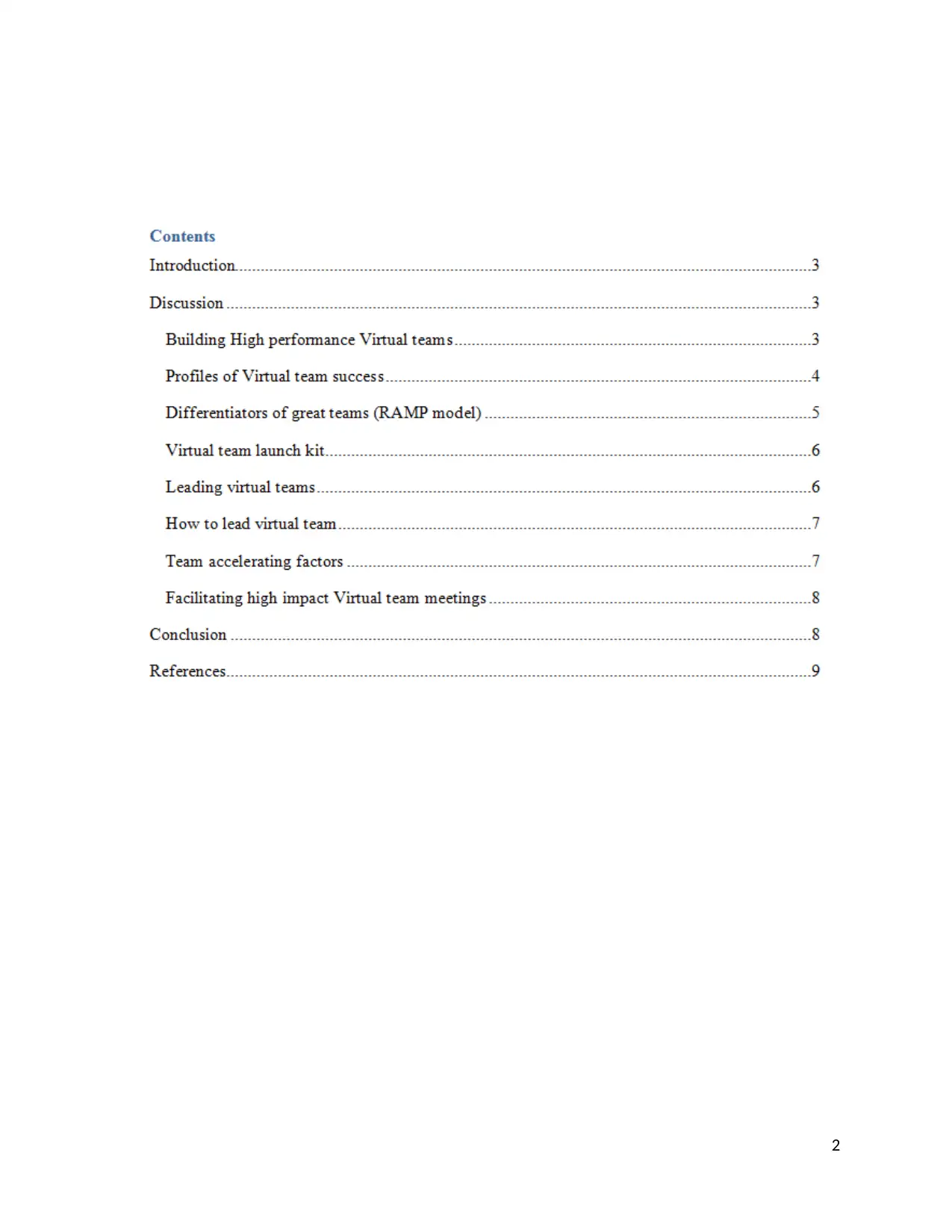
2
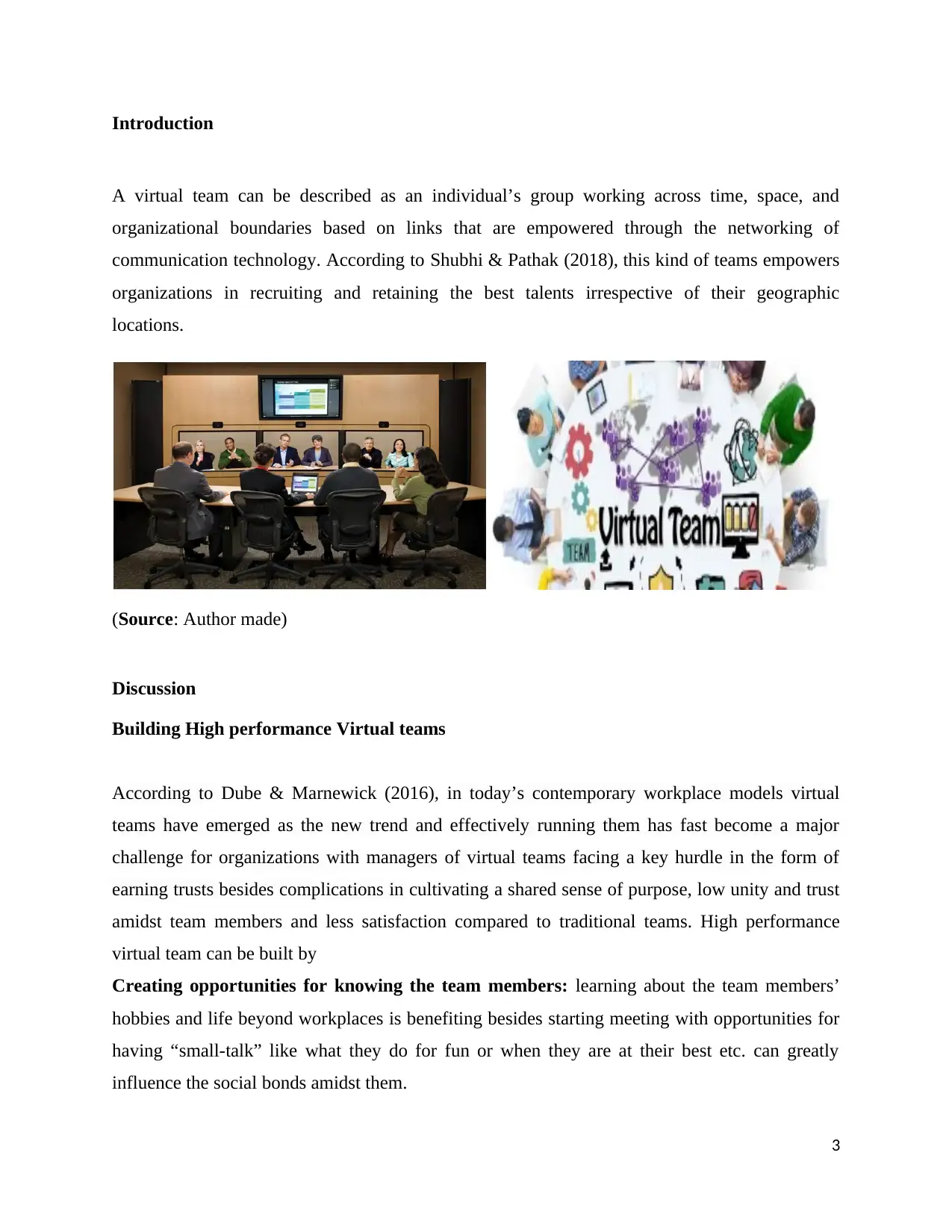
Introduction
A virtual team can be described as an individual’s group working across time, space, and
organizational boundaries based on links that are empowered through the networking of
communication technology. According to Shubhi & Pathak (2018), this kind of teams empowers
organizations in recruiting and retaining the best talents irrespective of their geographic
locations.
(Source: Author made)
Discussion
Building High performance Virtual teams
According to Dube & Marnewick (2016), in today’s contemporary workplace models virtual
teams have emerged as the new trend and effectively running them has fast become a major
challenge for organizations with managers of virtual teams facing a key hurdle in the form of
earning trusts besides complications in cultivating a shared sense of purpose, low unity and trust
amidst team members and less satisfaction compared to traditional teams. High performance
virtual team can be built by
Creating opportunities for knowing the team members: learning about the team members’
hobbies and life beyond workplaces is benefiting besides starting meeting with opportunities for
having “small-talk” like what they do for fun or when they are at their best etc. can greatly
influence the social bonds amidst them.
3
A virtual team can be described as an individual’s group working across time, space, and
organizational boundaries based on links that are empowered through the networking of
communication technology. According to Shubhi & Pathak (2018), this kind of teams empowers
organizations in recruiting and retaining the best talents irrespective of their geographic
locations.
(Source: Author made)
Discussion
Building High performance Virtual teams
According to Dube & Marnewick (2016), in today’s contemporary workplace models virtual
teams have emerged as the new trend and effectively running them has fast become a major
challenge for organizations with managers of virtual teams facing a key hurdle in the form of
earning trusts besides complications in cultivating a shared sense of purpose, low unity and trust
amidst team members and less satisfaction compared to traditional teams. High performance
virtual team can be built by
Creating opportunities for knowing the team members: learning about the team members’
hobbies and life beyond workplaces is benefiting besides starting meeting with opportunities for
having “small-talk” like what they do for fun or when they are at their best etc. can greatly
influence the social bonds amidst them.
3
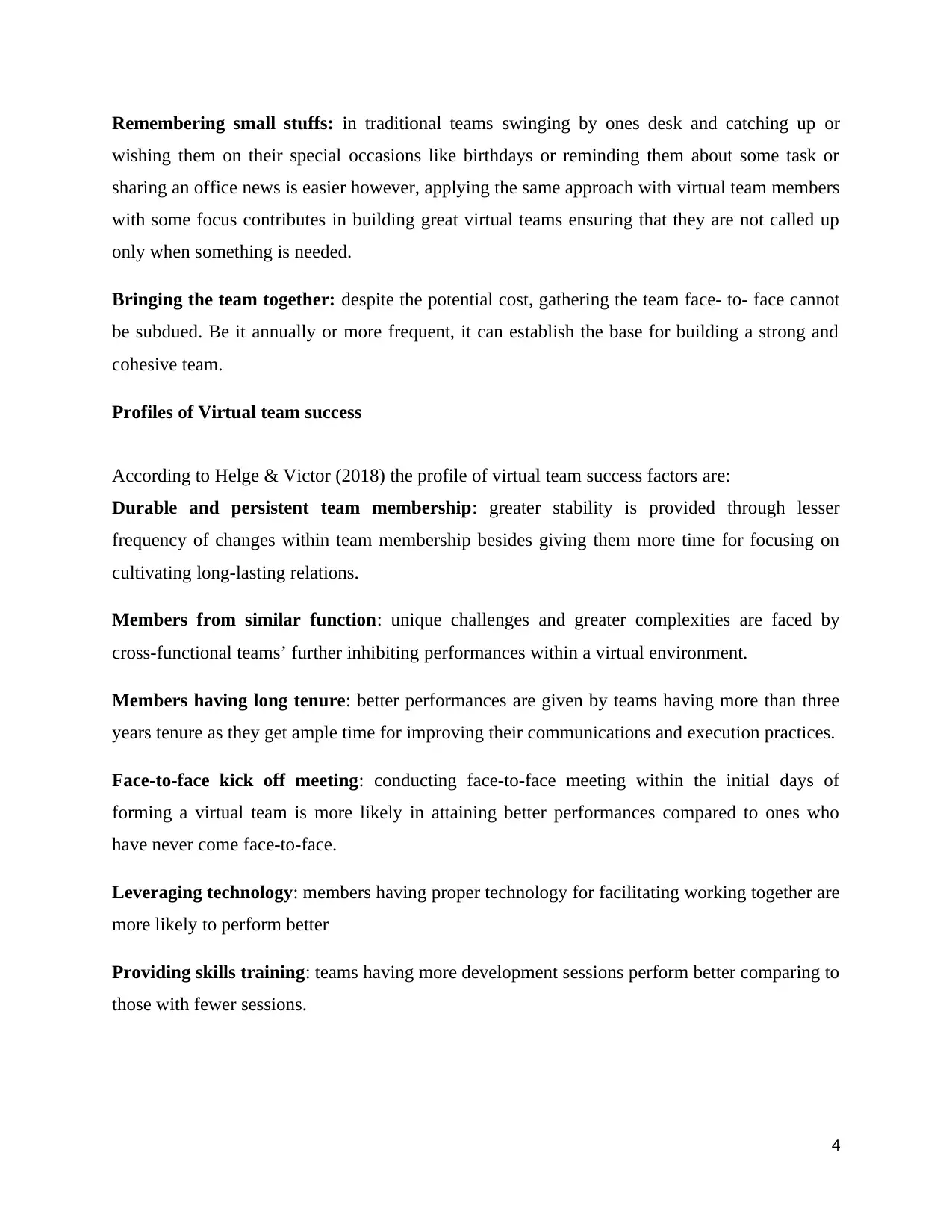
Remembering small stuffs: in traditional teams swinging by ones desk and catching up or
wishing them on their special occasions like birthdays or reminding them about some task or
sharing an office news is easier however, applying the same approach with virtual team members
with some focus contributes in building great virtual teams ensuring that they are not called up
only when something is needed.
Bringing the team together: despite the potential cost, gathering the team face- to- face cannot
be subdued. Be it annually or more frequent, it can establish the base for building a strong and
cohesive team.
Profiles of Virtual team success
According to Helge & Victor (2018) the profile of virtual team success factors are:
Durable and persistent team membership: greater stability is provided through lesser
frequency of changes within team membership besides giving them more time for focusing on
cultivating long-lasting relations.
Members from similar function: unique challenges and greater complexities are faced by
cross-functional teams’ further inhibiting performances within a virtual environment.
Members having long tenure: better performances are given by teams having more than three
years tenure as they get ample time for improving their communications and execution practices.
Face-to-face kick off meeting: conducting face-to-face meeting within the initial days of
forming a virtual team is more likely in attaining better performances compared to ones who
have never come face-to-face.
Leveraging technology: members having proper technology for facilitating working together are
more likely to perform better
Providing skills training: teams having more development sessions perform better comparing to
those with fewer sessions.
4
wishing them on their special occasions like birthdays or reminding them about some task or
sharing an office news is easier however, applying the same approach with virtual team members
with some focus contributes in building great virtual teams ensuring that they are not called up
only when something is needed.
Bringing the team together: despite the potential cost, gathering the team face- to- face cannot
be subdued. Be it annually or more frequent, it can establish the base for building a strong and
cohesive team.
Profiles of Virtual team success
According to Helge & Victor (2018) the profile of virtual team success factors are:
Durable and persistent team membership: greater stability is provided through lesser
frequency of changes within team membership besides giving them more time for focusing on
cultivating long-lasting relations.
Members from similar function: unique challenges and greater complexities are faced by
cross-functional teams’ further inhibiting performances within a virtual environment.
Members having long tenure: better performances are given by teams having more than three
years tenure as they get ample time for improving their communications and execution practices.
Face-to-face kick off meeting: conducting face-to-face meeting within the initial days of
forming a virtual team is more likely in attaining better performances compared to ones who
have never come face-to-face.
Leveraging technology: members having proper technology for facilitating working together are
more likely to perform better
Providing skills training: teams having more development sessions perform better comparing to
those with fewer sessions.
4
Secure Best Marks with AI Grader
Need help grading? Try our AI Grader for instant feedback on your assignments.
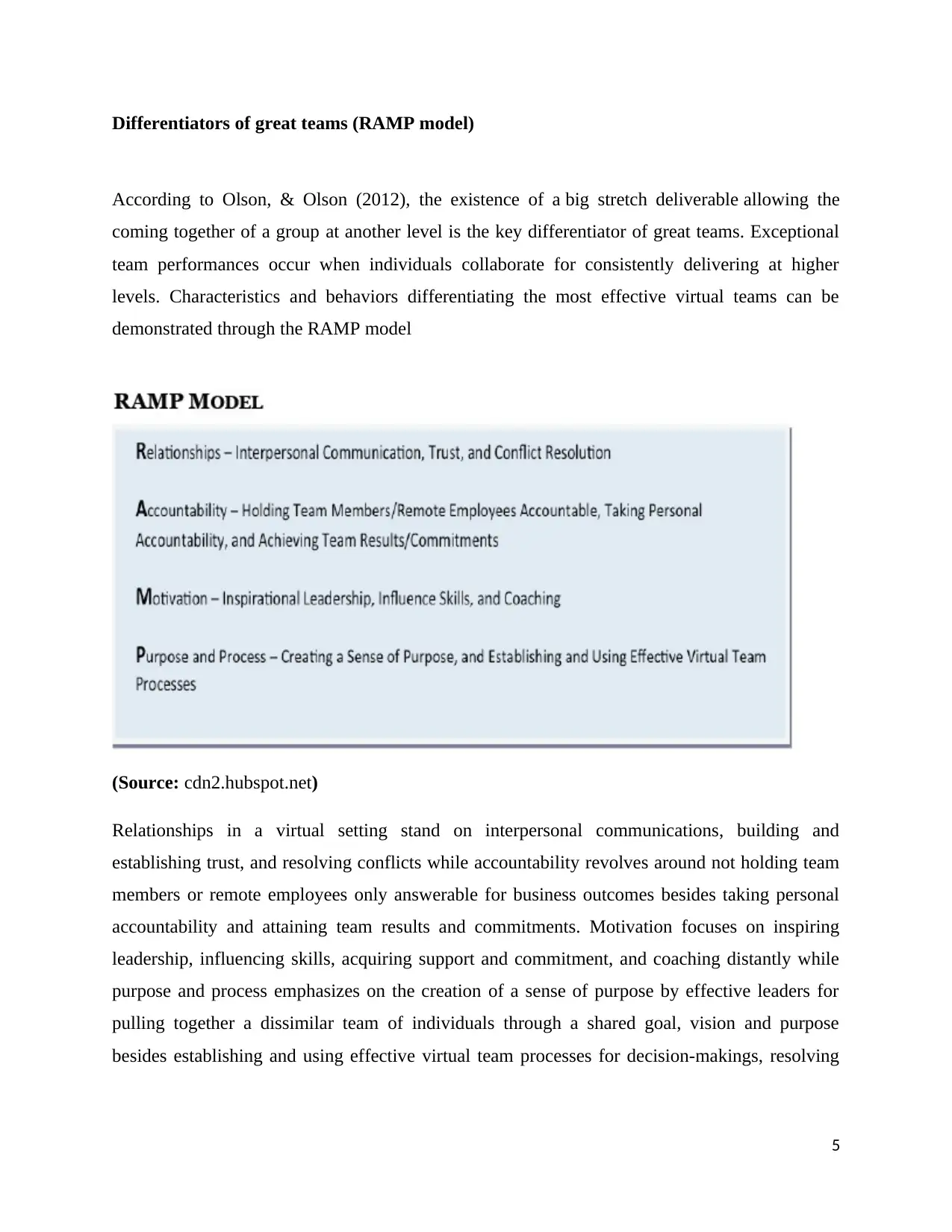
Differentiators of great teams (RAMP model)
According to Olson, & Olson (2012), the existence of a big stretch deliverable allowing the
coming together of a group at another level is the key differentiator of great teams. Exceptional
team performances occur when individuals collaborate for consistently delivering at higher
levels. Characteristics and behaviors differentiating the most effective virtual teams can be
demonstrated through the RAMP model
(Source: cdn2.hubspot.net)
Relationships in a virtual setting stand on interpersonal communications, building and
establishing trust, and resolving conflicts while accountability revolves around not holding team
members or remote employees only answerable for business outcomes besides taking personal
accountability and attaining team results and commitments. Motivation focuses on inspiring
leadership, influencing skills, acquiring support and commitment, and coaching distantly while
purpose and process emphasizes on the creation of a sense of purpose by effective leaders for
pulling together a dissimilar team of individuals through a shared goal, vision and purpose
besides establishing and using effective virtual team processes for decision-makings, resolving
5
According to Olson, & Olson (2012), the existence of a big stretch deliverable allowing the
coming together of a group at another level is the key differentiator of great teams. Exceptional
team performances occur when individuals collaborate for consistently delivering at higher
levels. Characteristics and behaviors differentiating the most effective virtual teams can be
demonstrated through the RAMP model
(Source: cdn2.hubspot.net)
Relationships in a virtual setting stand on interpersonal communications, building and
establishing trust, and resolving conflicts while accountability revolves around not holding team
members or remote employees only answerable for business outcomes besides taking personal
accountability and attaining team results and commitments. Motivation focuses on inspiring
leadership, influencing skills, acquiring support and commitment, and coaching distantly while
purpose and process emphasizes on the creation of a sense of purpose by effective leaders for
pulling together a dissimilar team of individuals through a shared goal, vision and purpose
besides establishing and using effective virtual team processes for decision-makings, resolving
5
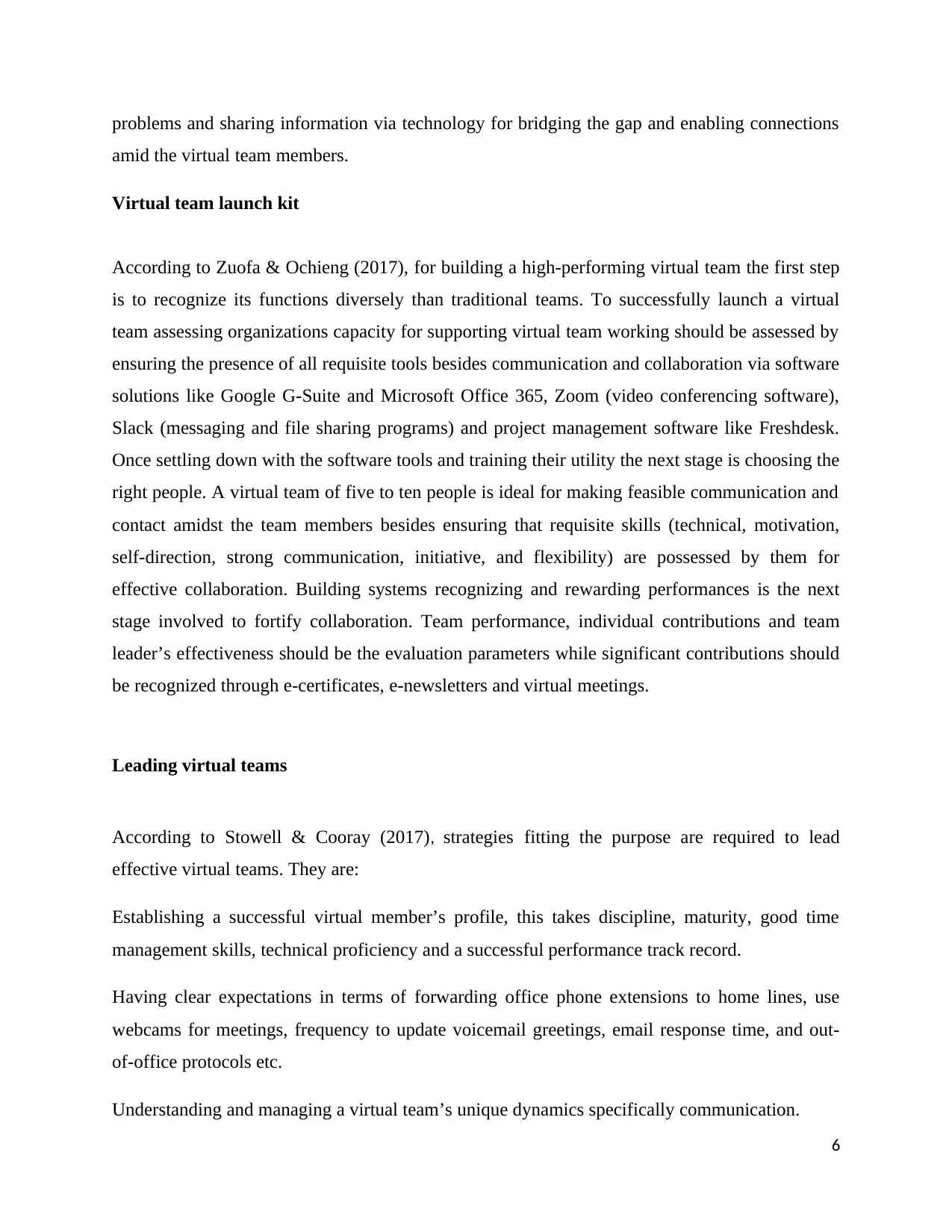
problems and sharing information via technology for bridging the gap and enabling connections
amid the virtual team members.
Virtual team launch kit
According to Zuofa & Ochieng (2017), for building a high-performing virtual team the first step
is to recognize its functions diversely than traditional teams. To successfully launch a virtual
team assessing organizations capacity for supporting virtual team working should be assessed by
ensuring the presence of all requisite tools besides communication and collaboration via software
solutions like Google G-Suite and Microsoft Office 365, Zoom (video conferencing software),
Slack (messaging and file sharing programs) and project management software like Freshdesk.
Once settling down with the software tools and training their utility the next stage is choosing the
right people. A virtual team of five to ten people is ideal for making feasible communication and
contact amidst the team members besides ensuring that requisite skills (technical, motivation,
self-direction, strong communication, initiative, and flexibility) are possessed by them for
effective collaboration. Building systems recognizing and rewarding performances is the next
stage involved to fortify collaboration. Team performance, individual contributions and team
leader’s effectiveness should be the evaluation parameters while significant contributions should
be recognized through e-certificates, e-newsletters and virtual meetings.
Leading virtual teams
According to Stowell & Cooray (2017), strategies fitting the purpose are required to lead
effective virtual teams. They are:
Establishing a successful virtual member’s profile, this takes discipline, maturity, good time
management skills, technical proficiency and a successful performance track record.
Having clear expectations in terms of forwarding office phone extensions to home lines, use
webcams for meetings, frequency to update voicemail greetings, email response time, and out-
of-office protocols etc.
Understanding and managing a virtual team’s unique dynamics specifically communication.
6
amid the virtual team members.
Virtual team launch kit
According to Zuofa & Ochieng (2017), for building a high-performing virtual team the first step
is to recognize its functions diversely than traditional teams. To successfully launch a virtual
team assessing organizations capacity for supporting virtual team working should be assessed by
ensuring the presence of all requisite tools besides communication and collaboration via software
solutions like Google G-Suite and Microsoft Office 365, Zoom (video conferencing software),
Slack (messaging and file sharing programs) and project management software like Freshdesk.
Once settling down with the software tools and training their utility the next stage is choosing the
right people. A virtual team of five to ten people is ideal for making feasible communication and
contact amidst the team members besides ensuring that requisite skills (technical, motivation,
self-direction, strong communication, initiative, and flexibility) are possessed by them for
effective collaboration. Building systems recognizing and rewarding performances is the next
stage involved to fortify collaboration. Team performance, individual contributions and team
leader’s effectiveness should be the evaluation parameters while significant contributions should
be recognized through e-certificates, e-newsletters and virtual meetings.
Leading virtual teams
According to Stowell & Cooray (2017), strategies fitting the purpose are required to lead
effective virtual teams. They are:
Establishing a successful virtual member’s profile, this takes discipline, maturity, good time
management skills, technical proficiency and a successful performance track record.
Having clear expectations in terms of forwarding office phone extensions to home lines, use
webcams for meetings, frequency to update voicemail greetings, email response time, and out-
of-office protocols etc.
Understanding and managing a virtual team’s unique dynamics specifically communication.
6
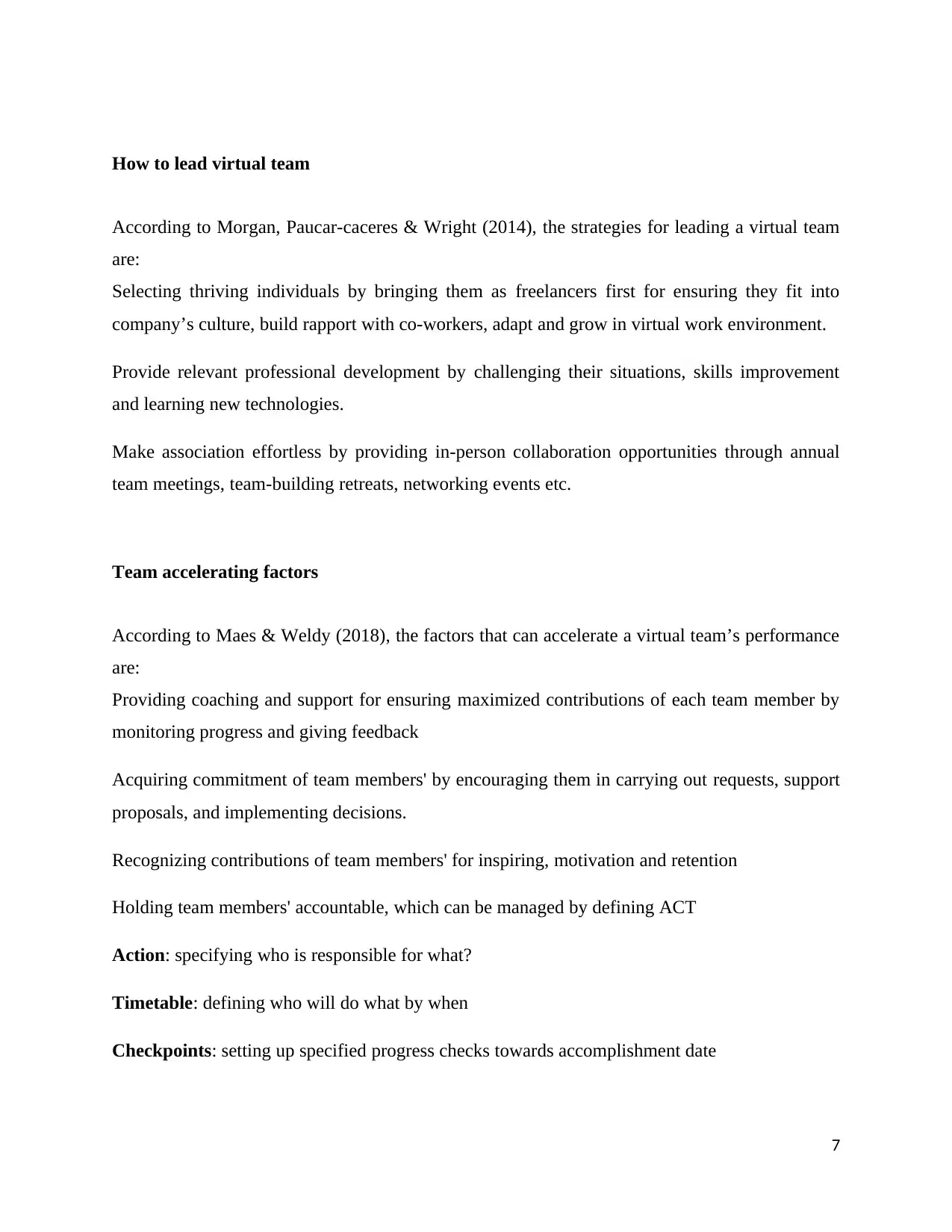
How to lead virtual team
According to Morgan, Paucar-caceres & Wright (2014), the strategies for leading a virtual team
are:
Selecting thriving individuals by bringing them as freelancers first for ensuring they fit into
company’s culture, build rapport with co-workers, adapt and grow in virtual work environment.
Provide relevant professional development by challenging their situations, skills improvement
and learning new technologies.
Make association effortless by providing in-person collaboration opportunities through annual
team meetings, team-building retreats, networking events etc.
Team accelerating factors
According to Maes & Weldy (2018), the factors that can accelerate a virtual team’s performance
are:
Providing coaching and support for ensuring maximized contributions of each team member by
monitoring progress and giving feedback
Acquiring commitment of team members' by encouraging them in carrying out requests, support
proposals, and implementing decisions.
Recognizing contributions of team members' for inspiring, motivation and retention
Holding team members' accountable, which can be managed by defining ACT
Action: specifying who is responsible for what?
Timetable: defining who will do what by when
Checkpoints: setting up specified progress checks towards accomplishment date
7
According to Morgan, Paucar-caceres & Wright (2014), the strategies for leading a virtual team
are:
Selecting thriving individuals by bringing them as freelancers first for ensuring they fit into
company’s culture, build rapport with co-workers, adapt and grow in virtual work environment.
Provide relevant professional development by challenging their situations, skills improvement
and learning new technologies.
Make association effortless by providing in-person collaboration opportunities through annual
team meetings, team-building retreats, networking events etc.
Team accelerating factors
According to Maes & Weldy (2018), the factors that can accelerate a virtual team’s performance
are:
Providing coaching and support for ensuring maximized contributions of each team member by
monitoring progress and giving feedback
Acquiring commitment of team members' by encouraging them in carrying out requests, support
proposals, and implementing decisions.
Recognizing contributions of team members' for inspiring, motivation and retention
Holding team members' accountable, which can be managed by defining ACT
Action: specifying who is responsible for what?
Timetable: defining who will do what by when
Checkpoints: setting up specified progress checks towards accomplishment date
7
Paraphrase This Document
Need a fresh take? Get an instant paraphrase of this document with our AI Paraphraser
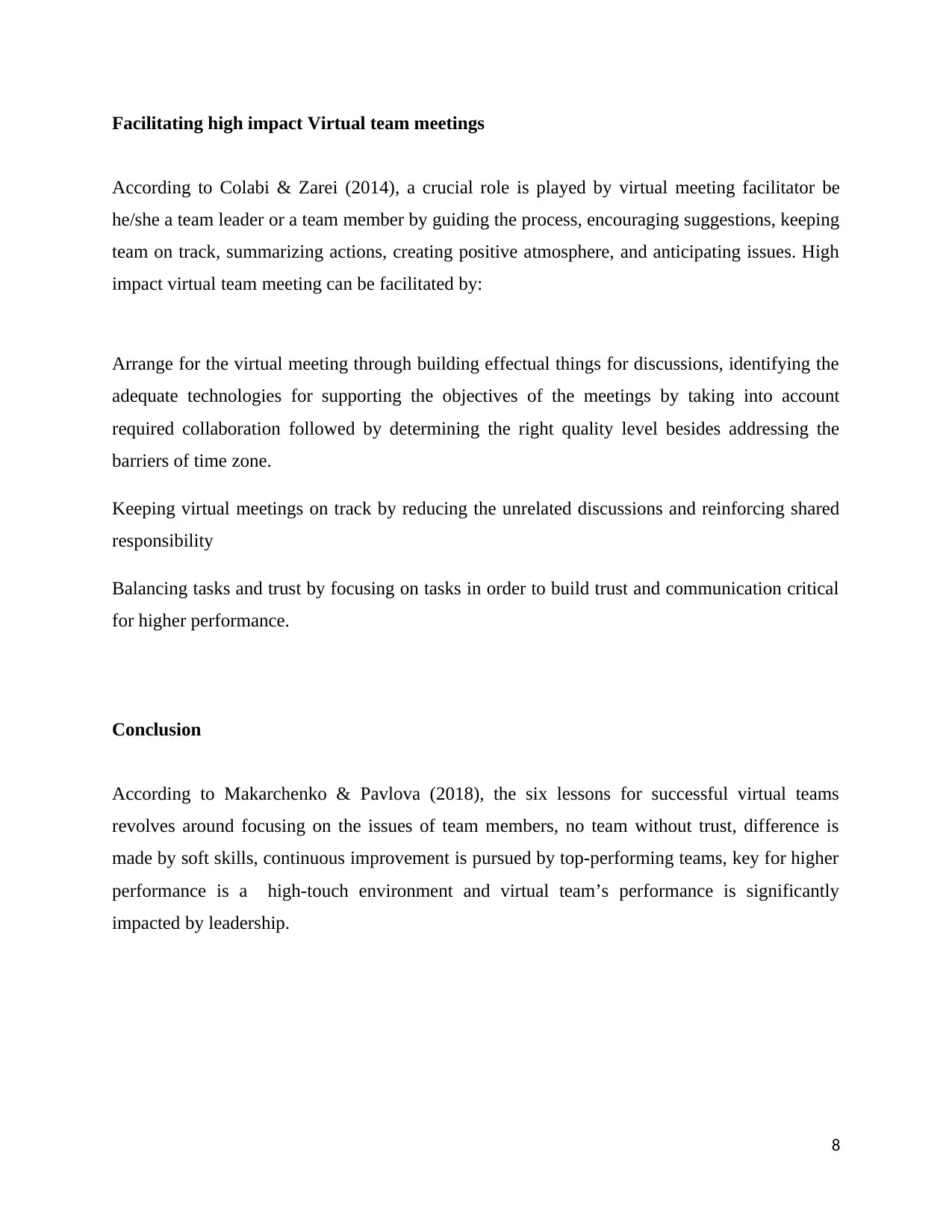
Facilitating high impact Virtual team meetings
According to Colabi & Zarei (2014), a crucial role is played by virtual meeting facilitator be
he/she a team leader or a team member by guiding the process, encouraging suggestions, keeping
team on track, summarizing actions, creating positive atmosphere, and anticipating issues. High
impact virtual team meeting can be facilitated by:
Arrange for the virtual meeting through building effectual things for discussions, identifying the
adequate technologies for supporting the objectives of the meetings by taking into account
required collaboration followed by determining the right quality level besides addressing the
barriers of time zone.
Keeping virtual meetings on track by reducing the unrelated discussions and reinforcing shared
responsibility
Balancing tasks and trust by focusing on tasks in order to build trust and communication critical
for higher performance.
Conclusion
According to Makarchenko & Pavlova (2018), the six lessons for successful virtual teams
revolves around focusing on the issues of team members, no team without trust, difference is
made by soft skills, continuous improvement is pursued by top-performing teams, key for higher
performance is a high-touch environment and virtual team’s performance is significantly
impacted by leadership.
8
According to Colabi & Zarei (2014), a crucial role is played by virtual meeting facilitator be
he/she a team leader or a team member by guiding the process, encouraging suggestions, keeping
team on track, summarizing actions, creating positive atmosphere, and anticipating issues. High
impact virtual team meeting can be facilitated by:
Arrange for the virtual meeting through building effectual things for discussions, identifying the
adequate technologies for supporting the objectives of the meetings by taking into account
required collaboration followed by determining the right quality level besides addressing the
barriers of time zone.
Keeping virtual meetings on track by reducing the unrelated discussions and reinforcing shared
responsibility
Balancing tasks and trust by focusing on tasks in order to build trust and communication critical
for higher performance.
Conclusion
According to Makarchenko & Pavlova (2018), the six lessons for successful virtual teams
revolves around focusing on the issues of team members, no team without trust, difference is
made by soft skills, continuous improvement is pursued by top-performing teams, key for higher
performance is a high-touch environment and virtual team’s performance is significantly
impacted by leadership.
8
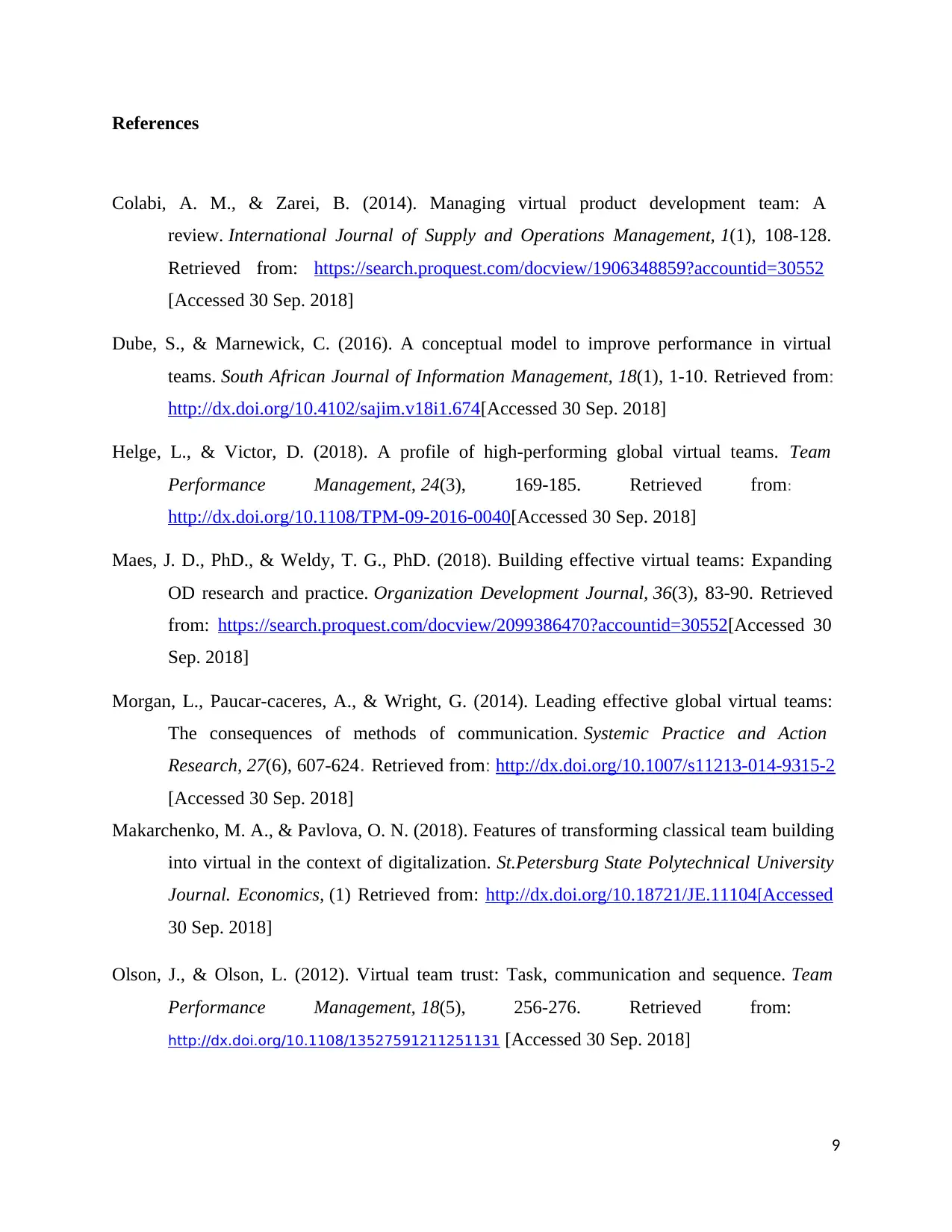
References
Colabi, A. M., & Zarei, B. (2014). Managing virtual product development team: A
review. International Journal of Supply and Operations Management, 1(1), 108-128.
Retrieved from: https://search.proquest.com/docview/1906348859?accountid=30552
[Accessed 30 Sep. 2018]
Dube, S., & Marnewick, C. (2016). A conceptual model to improve performance in virtual
teams. South African Journal of Information Management, 18(1), 1-10. Retrieved from:
http://dx.doi.org/10.4102/sajim.v18i1.674[Accessed 30 Sep. 2018]
Helge, L., & Victor, D. (2018). A profile of high-performing global virtual teams. Team
Performance Management, 24(3), 169-185. Retrieved from:
http://dx.doi.org/10.1108/TPM-09-2016-0040[Accessed 30 Sep. 2018]
Maes, J. D., PhD., & Weldy, T. G., PhD. (2018). Building effective virtual teams: Expanding
OD research and practice. Organization Development Journal, 36(3), 83-90. Retrieved
from: https://search.proquest.com/docview/2099386470?accountid=30552[Accessed 30
Sep. 2018]
Morgan, L., Paucar-caceres, A., & Wright, G. (2014). Leading effective global virtual teams:
The consequences of methods of communication. Systemic Practice and Action
Research, 27(6), 607-624. Retrieved from: http://dx.doi.org/10.1007/s11213-014-9315-2
[Accessed 30 Sep. 2018]
Makarchenko, M. A., & Pavlova, O. N. (2018). Features of transforming classical team building
into virtual in the context of digitalization. St.Petersburg State Polytechnical University
Journal. Economics, (1) Retrieved from: http://dx.doi.org/10.18721/JE.11104[Accessed
30 Sep. 2018]
Olson, J., & Olson, L. (2012). Virtual team trust: Task, communication and sequence. Team
Performance Management, 18(5), 256-276. Retrieved from:
http://dx.doi.org/10.1108/13527591211251131 [Accessed 30 Sep. 2018]
9
Colabi, A. M., & Zarei, B. (2014). Managing virtual product development team: A
review. International Journal of Supply and Operations Management, 1(1), 108-128.
Retrieved from: https://search.proquest.com/docview/1906348859?accountid=30552
[Accessed 30 Sep. 2018]
Dube, S., & Marnewick, C. (2016). A conceptual model to improve performance in virtual
teams. South African Journal of Information Management, 18(1), 1-10. Retrieved from:
http://dx.doi.org/10.4102/sajim.v18i1.674[Accessed 30 Sep. 2018]
Helge, L., & Victor, D. (2018). A profile of high-performing global virtual teams. Team
Performance Management, 24(3), 169-185. Retrieved from:
http://dx.doi.org/10.1108/TPM-09-2016-0040[Accessed 30 Sep. 2018]
Maes, J. D., PhD., & Weldy, T. G., PhD. (2018). Building effective virtual teams: Expanding
OD research and practice. Organization Development Journal, 36(3), 83-90. Retrieved
from: https://search.proquest.com/docview/2099386470?accountid=30552[Accessed 30
Sep. 2018]
Morgan, L., Paucar-caceres, A., & Wright, G. (2014). Leading effective global virtual teams:
The consequences of methods of communication. Systemic Practice and Action
Research, 27(6), 607-624. Retrieved from: http://dx.doi.org/10.1007/s11213-014-9315-2
[Accessed 30 Sep. 2018]
Makarchenko, M. A., & Pavlova, O. N. (2018). Features of transforming classical team building
into virtual in the context of digitalization. St.Petersburg State Polytechnical University
Journal. Economics, (1) Retrieved from: http://dx.doi.org/10.18721/JE.11104[Accessed
30 Sep. 2018]
Olson, J., & Olson, L. (2012). Virtual team trust: Task, communication and sequence. Team
Performance Management, 18(5), 256-276. Retrieved from:
http://dx.doi.org/10.1108/13527591211251131 [Accessed 30 Sep. 2018]
9
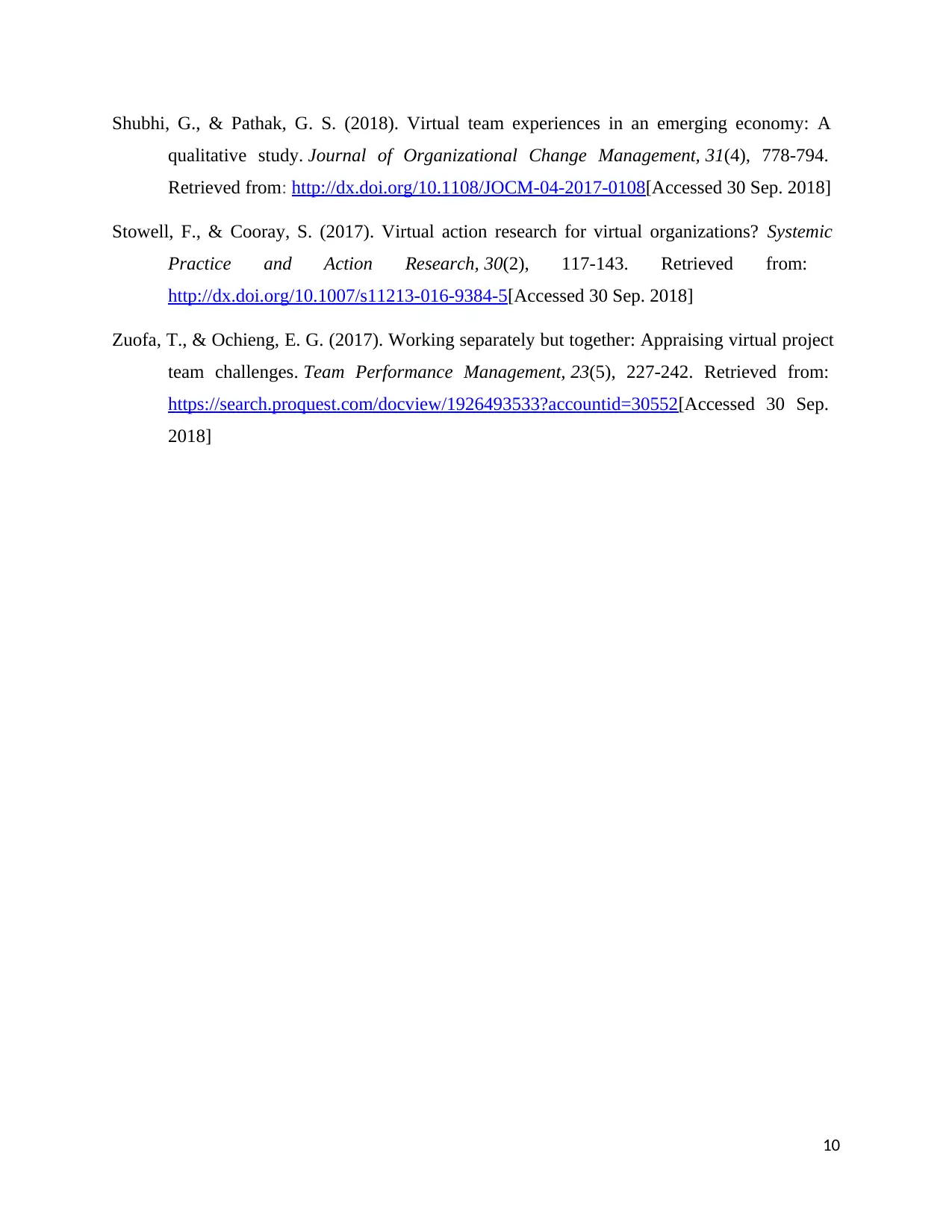
Shubhi, G., & Pathak, G. S. (2018). Virtual team experiences in an emerging economy: A
qualitative study. Journal of Organizational Change Management, 31(4), 778-794.
Retrieved from: http://dx.doi.org/10.1108/JOCM-04-2017-0108[Accessed 30 Sep. 2018]
Stowell, F., & Cooray, S. (2017). Virtual action research for virtual organizations? Systemic
Practice and Action Research, 30(2), 117-143. Retrieved from:
http://dx.doi.org/10.1007/s11213-016-9384-5[Accessed 30 Sep. 2018]
Zuofa, T., & Ochieng, E. G. (2017). Working separately but together: Appraising virtual project
team challenges. Team Performance Management, 23(5), 227-242. Retrieved from:
https://search.proquest.com/docview/1926493533?accountid=30552[Accessed 30 Sep.
2018]
10
qualitative study. Journal of Organizational Change Management, 31(4), 778-794.
Retrieved from: http://dx.doi.org/10.1108/JOCM-04-2017-0108[Accessed 30 Sep. 2018]
Stowell, F., & Cooray, S. (2017). Virtual action research for virtual organizations? Systemic
Practice and Action Research, 30(2), 117-143. Retrieved from:
http://dx.doi.org/10.1007/s11213-016-9384-5[Accessed 30 Sep. 2018]
Zuofa, T., & Ochieng, E. G. (2017). Working separately but together: Appraising virtual project
team challenges. Team Performance Management, 23(5), 227-242. Retrieved from:
https://search.proquest.com/docview/1926493533?accountid=30552[Accessed 30 Sep.
2018]
10
1 out of 10
Related Documents
Your All-in-One AI-Powered Toolkit for Academic Success.
+13062052269
info@desklib.com
Available 24*7 on WhatsApp / Email
![[object Object]](/_next/static/media/star-bottom.7253800d.svg)
Unlock your academic potential
© 2024 | Zucol Services PVT LTD | All rights reserved.





